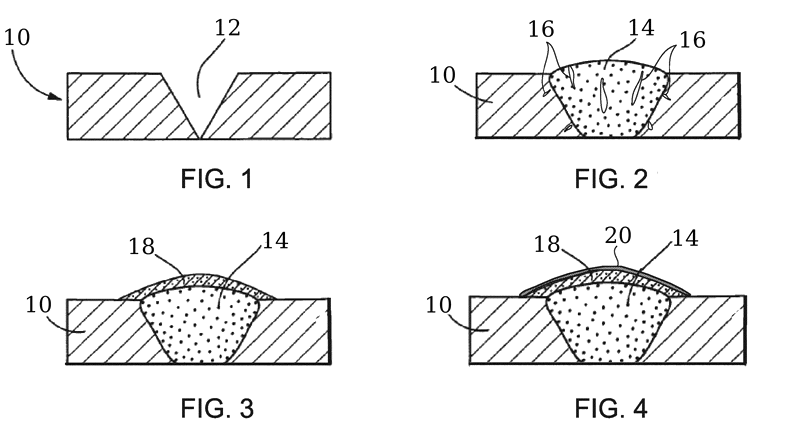High gamma prime superalloys exhibit excellent mechanical properties and corrosion-resistance at elevated temperatures, making them suitable for a variety of applications in aerospace, marine and chemical industries.
However, welding of these superalloys, including Rene 108, can result in cracking of both the weld and the heat-affected zone of the base metal due to the lack of ductility for accommodating thermally induced residual stresses.
In September 2021, General Electric Company was granted European patent EP3417972B1 designating the UK, titled Method of Welding Superalloys.
The patent claims a method of welding a superalloy component (10) comprising the steps of a) welding a cavity (12) in the component using a filler metal (14) in an inert atmosphere; b) covering the weld filler layer (18) with a braze material (20) and performing a brazing operation; and c) heating the component by hot isostatic pressing.
The patented method is characterised in that after step a) but before step b), a portion of the component is covered with a weld filler layer in the inert atmosphere, wherein the weld filler layer has a greater ductility than that of the component and filler metal materials. Figures 1-4 show the steps involved in the patented method.
Welding of the superalloy component is performed in an inert atmosphere to reduce oxidation. However, surface cracks (16) may inevitably form in both the weld filler material and the heat affected zone of the component. Optionally, the filler metal may be one of GTD-262, GTD-111, R-108LC, R-108, MAR-M 247, IN 738, or GTD-222.
Optionally, the superalloy may be one of B-1900, GTD-111, Inconel 100, Inconel 713, Inconel 738, Inconel 792, Inconel 939, MAR-M 246, MAR-M 509, Rene 77, Rene 108, Rene 125, U-500, CM 247, or MAR-M 247.
The ductile weld filler layer is used to cover the exposed surface of the weld filler material and the adjacent surfaces of the component. Small cracks or ‘sub-cracks’ may still be present in both the weld filler material and the component. The weld filler layer may include one of nickel, H-230, Inconel 600, Inconel 617, Inconel 625, or Yanalloy.
During the brazing step, the surfaces of the fusion zone are covered with a braze material and the sub-cracks are filled. Optionally, the braze material may include one of D15, DF-4B, Amdry 788, MM509B, Amdry 775, 50% nickel/50% D15, 60% IN625/40% Amdry 788, 50% MAR-M 247/50% DF-4B.
The patent further discloses that while the ductile weld filler layer and the braze material can flow into and fill the surface cracks and the sub-cracks, respectively, the weld filler layer may also seal the main filler metal to prevent infiltration of the braze material into the cracks, which could otherwise adversely affect the ductility of the weld.
Following the brazing procedure, the component is subjected to hot isostatic pressing to heal the remaining cracks. Hot isostatic pressing may be performed at a temperature lower than the brazing temperature used in the process. A further solution heat treatment may be performed after the hot isostatic pressing heat treatment.
Read the full patent here
This article first appeared in the April 2022 issue of Materials World, the member magazine of the Institute of Materials, Minerals and Mining.


